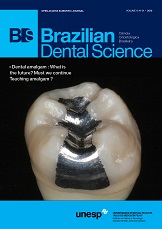Periapical tissue repair of dog teeth after intracanal administration of capsaicin 0.075%
DOI:
https://doi.org/10.14295/bds.2015.v18i1.1070Abstract
Objective: The aim of this study was make a descriptively evaluate the repair of the periapical region of dog teeth. Material and Methods: Thirty-six root canals were used,eighteen were filled with 0.075% capsaicin and calcium hydroxide (test paste)and the rest eighteen root canals were filled with calcium hydroxide (control group). Histological analyzes were performed to classify inflammation as absent, mild, moderate or severe. The analyses also classified the presence or absence of repairat 7, 14 and 30 days.Results: The use of 0.075% capsaicin did not modify the inflammatory response and repairwhen compared to control group. Conclusion: Our data suggests that test group with 0.075% capsaicin as intracanal administration could be indicated for tissue repair; furthermore other experiments should be carried out to evaluate possible clinical use of capsaicin for atypical odontalgia.
Keywords: Capsaicin; Repair; Inflammation; Periapical tissue.
Downloads
Downloads
Published
How to Cite
Issue
Section
License
Brazilian Dental Science uses the Creative Commons (CC-BY 4.0) license, thus preserving the integrity of articles in an open access environment. The journal allows the author to retain publishing rights without restrictions.
=================




























